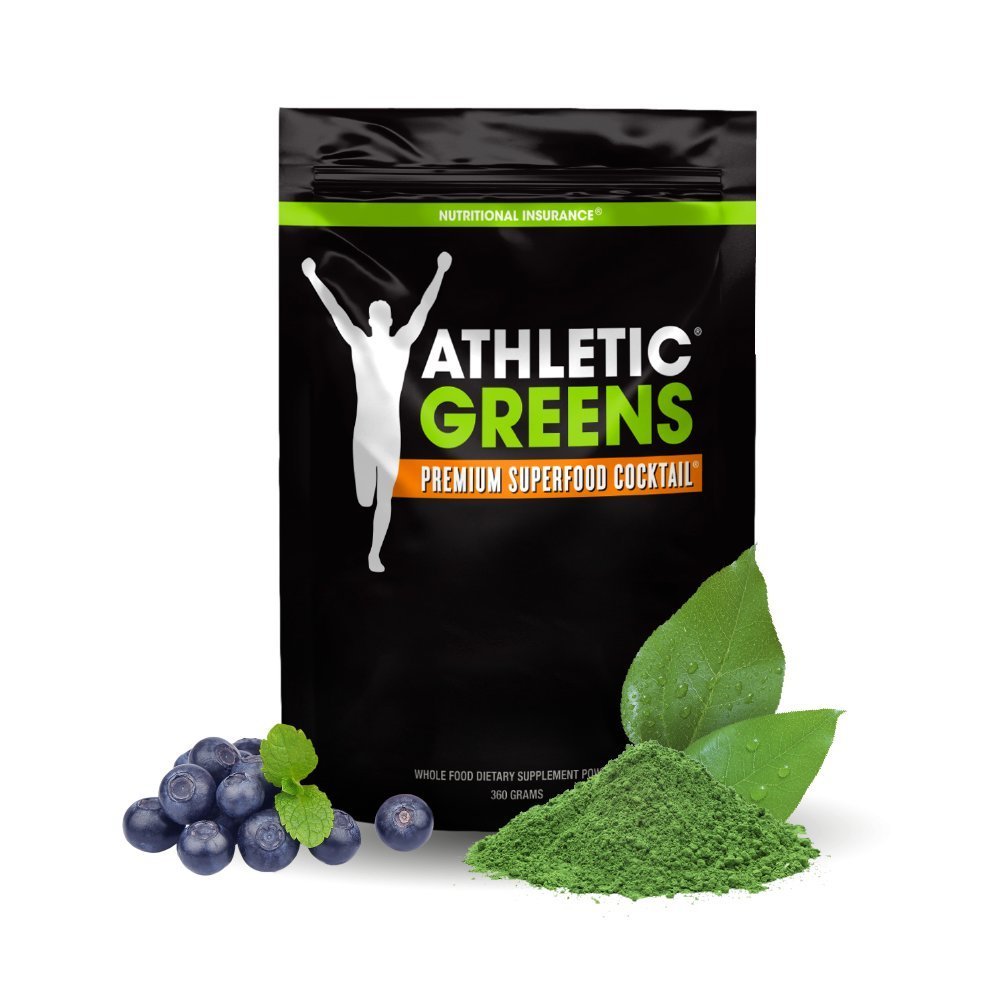Athletic Greens is a powder-based greens drink that aims to condense and supply a blend of superfoods — fruits and vegetables that are unusually powerful in their health benefits.
It’s also endorsed by super-bodyhacker Tim Ferriss, who doesn’t have too many blemishes on his brand.
Athletic Greens is loaded with over 70 ingredients – giving people who are “on-the-go” nutritional insurance that is almost unrivaled.
In our green drinks testing, we found Athletic Greens to be a top-3 winner in the category.

Click here for the lowest price
Ingredients
The nutrition label for Athletic Greens reads like a label from a multivitamin—almost every core vitamin and mineral have close to or over 100% of your recommended daily intake. Vitamin C, vitamin E, vitamin K, the B-complex vitamins, and zinc are all present in near or above 100% daily value. There are a few notable exceptions: there is no notable amount of iron in Athletic Greens, relatively small amounts of magnesium and calcium, and very little dietary fiber and protein.
It’s important to remember that these vitamins and minerals are not being added directly to the formulation as they would be in a traditional supplement—they are the result of the fruit and vegetable ingredients, and as such, this explains some of the absences. Iron, for example, is much more abundant in animal foods than it is in plant foods. The same is true for calcium.
The actual ingredient list reads like a who’s who of superfoods: spirulina, wheatgrass, alfalafa, cherry fruit, spinach leaves, green tea extract, and more make up the “raw superfood complex.”
In addition to this, Athletic Greens also contains a number of herbal extracts with suspected health or fitness benefits. These include citrus bioflavonoids, artichoke leaf extract, milk thistle extract, and a small amount of stevia for natural sweetening. Notably, the extraction process for most of the fruits and vegetables strips them of their sugars, so the sugar content of Athletic Greens is almost zero.
A few dietary enzymes and probiotics round out the formulation; these are likely included to aid in digesting and absorbing the bioactive compounds in the fruit and vegetable extracts.
Benefits
Much of the rationale for green drinks like Athletic Greens comes from a strange realization in the medical community in the last few decades. By freeze-drying and powderizing real fruits and vegetables, a green drink aims to provide the same benefits of real fruits and vegetables in a more easily consumed form.
For a long time, scientific researchers knew that a diet high in fruits and vegetables was tremendously healthy. A 2013 review study by researchers at the Karolinska Institutet in Sweden, for example, found that high fruit and vegetable consumption rates (five servings per day or more) was associated with a dramatic decrease in death rates of any cause—to the tune of over fifty percent (1). Other research on heart disease and specific types of cancer are similarly stark. A 2006 study in the Journal of Nutrition found that each serving of fruit per day reduces your risk of cardiovascular disease by about 7%, and a 2000 study in the Journal of the National Cancer Institute found that vegetable consumption drastically reduced prostate cancer risk (2, 3).
Despite this, studies which have tried to use the nutrients in fruits and vegetables as direct supplements have had poor results. For example, a 2008 study in the Journal of the American Medical Association studied a large group of men taking vitamin E and vitamin C, which are both present in high amounts in healthy fruits and vegetables, like citrus fruits and spinach (4). Despite this, over the eight-year duration of the study, neither vitamin C nor vitamin E had any tangible effect on the incidence of heart disease.
Scientists couldn’t resolve this apparent paradox until they started examining what else is in fruits and vegetables, other than the basic nutrients we already know about. A study out of Harvard Medical School and Brigham and Women’s Hospital in Boston found that tracking the consumption of carotenoids, another bioactive compound in fruits and vegetables, was a good predictor of cardiovascular disease risk in elderly people (5). So, there’s more to a fruit or a vegetable than just its vitamin content; this is exactly the premise of Athletic Greens.
There is still some key information missing—can a powderized and dried extract form of a fruit or vegetable be as effective as the real thing? There haven’t been any large-scale studies in humans yet, but evidence from lab animals seems promising. Lab rats with high blood lipid levels, for example, appear to benefit significantly from a powderized spinach extract like the kind included in Athletic Greens (6).
How to use
Athletic greens should be used as a morning ritual, a meal replacement (or meal addition) or a post-exercise drink. Given that it contains green tea extract, it may not be the best idea to take it before bed—there is some amount of naturally occurring caffeine which could keep you up. But beyond that, take it any time you would normally consume fruits and vegetables.
Recap
While the ingredient label on Athletic Greens looks like a multivitamin on steriods (and indeed, it could function as a pretty good replacement for one if you can get the missing nutrients elsewhere in your diet), it’s really more of a concentrated way to increase your fruit and vegetable consumption. If the core premise of the product is correct—that a powderized and extracted fruit or vegetable concentrate is as effective as the real thing, Athletic Greens is a great way to boost your overall health and well-being.
https://bodynutrition.org/athletic-greens/
No comments:
Post a Comment